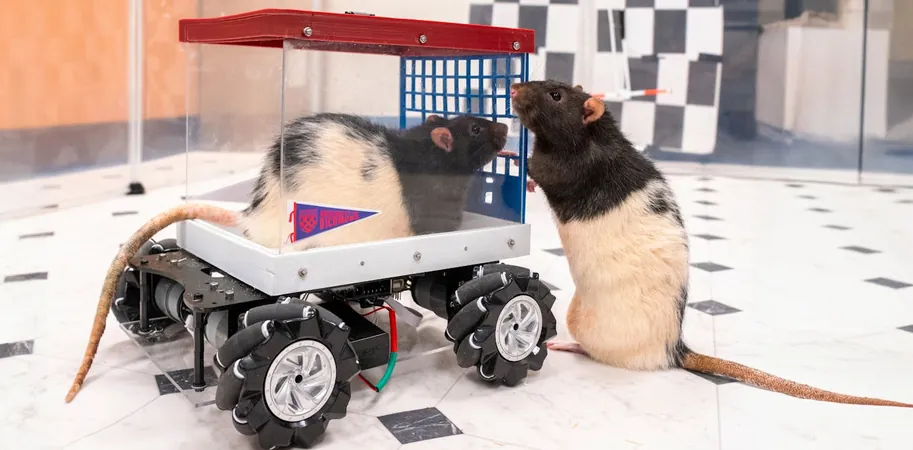
The Incredible Journey of Driving Rats: What They Teach Us About Joy and Anticipation
2024-11-11
Author: Li
Introduction
In a fascinating experiment blending neuroscience with playful ingenuity, researchers crafted a makeshift rodent car from a simple plastic cereal container, paving the way for an astonishing study on animal behavior. These clever rats learned to drive forward by grasping a lever that functioned as a gas pedal, and before long, they were navigating their tiny vehicles with surprising precision in pursuit of a tantalizing Froot Loop reward.
Groundbreaking Findings
The findings were groundbreaking—rats raised in enriched environments, complete with toys, ample space, and social companions, learned the driving task significantly faster than those kept in standard cages. This highlighted a crucial link between stimulating environments and neuroplasticity—the brain's remarkable ability to adapt and change in response to its surroundings throughout an individual's life.
Evolution of the Research
After gaining media attention for this groundbreaking research, the project continues to evolve in the lab, with new and improved rat-operated vehicles (ROVs) designed by robotics professor John McManus and his students. These state-of-the-art rat vehicles are equipped with rat-proof wiring and durable components, comparable to a rodent version of Tesla's Cybertruck.
The Deeper Message
While the experiment may seem whimsical, there's a deeper message to uncover. Just as humans did not evolve to drive cars, rats are not naturally inclined to engage with plastic objects. But by teaching them this new skill, researchers discovered the significance of anticipation in their behavior—a powerful motivator, akin to the joy humans experience when looking forward to enjoyable activities.
The Impact of Anticipation
During the summer of 2020, amidst global isolation due to the pandemic, something remarkable became evident in the lab. The trained rats instinctively rushed to the edge of their enclosure, eagerly jumping in a manner reminiscent of a dog being asked if it wants to go for a walk. Were they simply excited about their beloved Froot Loops, or was it the thrill of the anticipated drive that fueled their enthusiasm? This raised a profound question: Can rodents feel something akin to joy?
Shifting Focus to Positive Emotions
Further investigations shifted the team's focus from negative emotions like stress to understanding how positive experiences and the excitement leading up to them affect brain functions. Working alongside postdoctoral fellow Kitty Hartvigsen, the researchers devised an experiment called "Wait For It," which incorporated waiting periods to amplify anticipation before granting the rats their rewards. This method included Pavlovian conditioning techniques, where rats had to endure waiting times before receiving their Froot Loops after certain stimuli were introduced.
Preliminary Results
The excitement didn't stop here. Preliminary results showcased that rats who anticipated their rewards exhibited more optimistic behavior and were able to tackle cognitive challenges with greater success compared to those receiving immediate rewards. This shift in behavior aligns with the broader research interest known as "behaviorceuticals"—the idea that experiences can influence brain chemistry similarly to medications.
Unexplored Expressions of Emotion
One remarkable observation arose during the research: one rat displayed a unique tail posture reminiscent of a crook, bringing attention to an unexplored expression of emotion in rodents. This posture correlated with the anticipation training and was linked to dopamine levels—indicating a potential newfound understanding of how rats express positivity.
Enjoyment of the Journey
In an innovative twist, researchers tested whether the rats truly enjoyed their driving experience. When given the option to walk to their Froot Loops or drive, many rats opted for the longer, more effortful drive, suggesting that they relished the journey as much as the reward.
Parallels in Animal Neuroscience
This research parallels other findings in the field of animal neuroscience, including studies by renowned neuroscientists like Jaak Panksepp, who revealed that rats can experience joy through play, and Curt Richter, who illustrated the concept of hope in rats through survival experiments.
Conclusion
The exploration into the world of driving rats has opened unexpected avenues in behavioral neuroscience, demonstrating that while understanding negative emotions like fear and stress is essential, positive experiences illuminate the profound ways our brains can be shaped. As these delightful journeys continue to unfold, the synergy of joy, anticipation, and cognition raises thought-provoking questions about emotional experiences in both rats and humans alike.



 Brasil (PT)
Brasil (PT)
 Canada (EN)
Canada (EN)
 Chile (ES)
Chile (ES)
 España (ES)
España (ES)
 France (FR)
France (FR)
 Hong Kong (EN)
Hong Kong (EN)
 Italia (IT)
Italia (IT)
 日本 (JA)
日本 (JA)
 Magyarország (HU)
Magyarország (HU)
 Norge (NO)
Norge (NO)
 Polska (PL)
Polska (PL)
 Schweiz (DE)
Schweiz (DE)
 Singapore (EN)
Singapore (EN)
 Sverige (SV)
Sverige (SV)
 Suomi (FI)
Suomi (FI)
 Türkiye (TR)
Türkiye (TR)